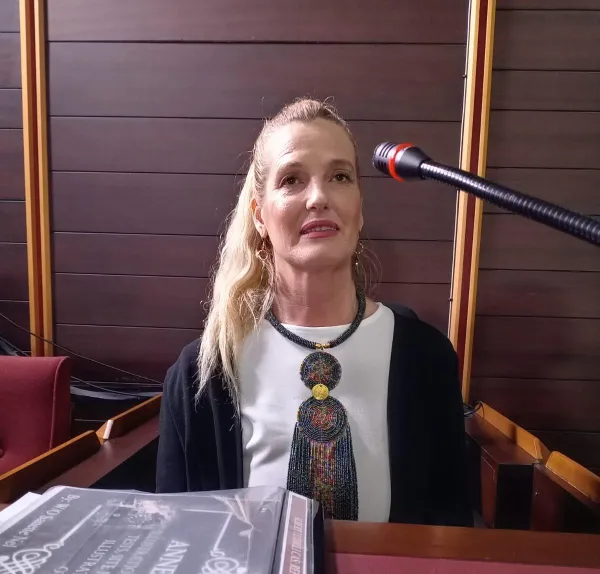Expert testimony suggests foul play in Albert Luthuli's death

Warrant Officer Sunette Nel told the inquest that Inkosi Albert Luthuli might have been assaulted instead of being hit by a train.
Image: Bongani Hans
THE possibility was that Inkosi Albert Luthuli was assaulted in the vicinity of the Mvoti River in Groutville, Stanger, before assailants carried him onto the railway bridge where they hastily left him, thinking he was dead, when they saw a train approaching.
This was the expert opinion of Warrant Officer Sunette Nel at the Pietermaritzburg High Court when she was testifying on Tuesday at the inquest into the Nobel Peace Prize recipient’s death.
According to the outcome of the police forensic artist’s investigation, which reconstructed what happened on the morning of July 21, 1967 - the day Luthuli succumbed to his head and body injuries - the injuries on Luthuli’s body were not similar to those of a person who was hit by a train.
The ANC president-general died shortly after being brought to the Stanger Hospital with an open gash on the back of the head, bruises on both his arms, and damaged ribs on July 21, 1967.
“The size of a blunt force trauma, such as the bruises, the lacerations, and fractures on the back of the head, arms, and hands, indicated that Chief Albert Luthuli was trying to protect himself as he was most likely to be assaulted,” said Nel.
She presented to the court gory pictures of someone, not Luthuli, with a partially decapitated body, limbs sustained during a train accident, which were not similar to those sustained by Luthuli. She was demonstrating what injuries someone hit by a train would suffer.
Nel was refuting sworn statements, which train driver Stephanus Lategan, his conductor Pieter van Wyk, and his boilerman Daniel Greylings presented to the inquest held in the same year.
She said during her investigation, she followed all the information she received, “no matter how ridiculous it was”.
The outcome of the initial inquest was that Luthuli was injured in an honest train accident as he was trying to cross the railway bridge to his sugarcane farm after 10am.
Lategan told the 1967 inquest that on realising a black man, who was Luthuli, was walking on the walkway of the railway bridge approaching the oncoming train, he blew a horn and only applied brakes a few seconds before witnessing the train, which was running at a speed of 40 kilometres per hour, hit him.
However, Nel said Lategan might have only applied the brakes after realising that something other than a person walking was on the bridge.
When asked why Lategan and his crew lied about the train accident, she said she did not have a comment.
In the reconstruction of the investigation about what happened on the day Luthuli was killed, Nel visited steam train museums in Hilton outside Pietermaritzburg and Hermanstad outside Pretoria.
She also collected statements that were presented by three doctors who examined Luthuli’s body at the Stanger Hospital mortuary.
She said, looking at the height of the train that supposedly hit Luthuli, what was presented at the initial inquest was not true, because the part that was said to have struck him on the shoulder was higher than where he was standing on the bridge’s walkway.
She stated that even the time Luthuli left his shop for the sugarcane field did not tally with the time of the train accident.
She said Luthuli’s shop employee had submitted a statement to the initial inquest that Luthuli left the shop at about 10am.
She said during her simulation walk, she established that Luthuli might have walked 15 minutes from the shop to the bridge. She said during the walk, she was accompanied by Wilhemina Luthuli so that she would be at almost the same pace that Luthuli walked as an elderly person at the time.
According to Nel, Luthuli would have arrived at the bridge at 10.38 am, which was approximately a 13-minute walk.
She said the train had passed a nearby station, which Luthuli also walked past, much later, and Luthuli should have reached the bridge before it.
She established that the assailants had sufficient time to assault Luthuli until he lost consciousness, which made them believe that he was dead.
Nel said they carried his body to the bridge, but because he was too heavy as a result of being unconscious, they got tired and placed him down, where a pool of blood was later discovered.
She said they lifted him again and continued to carry him, but because they had realised that the train was too close, instead of placing him on the railway line, they just threw his body next to the rail and ran away before they could be seen.
She added that they aimed to place Luthuli's body on the railway line so that it could be crushed by the train, thereby creating a false impression of the cause of his death.
“When they saw the train coming, they had no time, but they just threw the body,” she said.
Train expert Lesly Labuschagne testified last week that had Lategan seen Luthuli walking on the bridge, he would have blown the horn and slowed down the train to avoid the accident.
He also revealed that the station master allowed Lategang to continue driving the train to Durban, leaving the scene of the accident despite the trauma of hitting someone, because the train had not hit anyone. The train left the scene before the ambulance arrived, and the accident scene investigators arrived.
Nel said if the train had indeed hit Luthuli, it would have meant that Lategan left the scene with vital evidence of the accident on the train.
Cape Times
Related Topics: